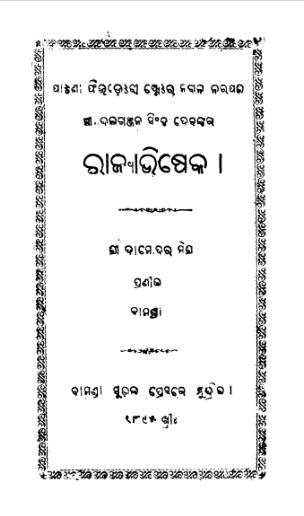The late 19th century marked a pivotal period in the cultural and literary landscape of Odisha, and one of the standout works from this era is Rajyabhiseka, a poetic masterpiece by the illustrious poet Damodara Misra, published in 1895. This collection encapsulates not only the artistry of Odia poetry but also reflects the social and political sentiments of the time, offering a profound exploration of themes such as empowerment, identity, and the rich tapestry of Odia culture.
Rajyabhiseka, meaning Coronation, serves as an allegorical representation of the quest for self-realization and the establishment of one’s rightful place in society. Damodara Misra masterfully weaves together rich metaphors and vivid imagery, creating a poetic narrative that resonates with the aspirations and struggles of his people. The title itself evokes a sense of nobility and authority, suggesting a reclaiming of identity and the pursuit of dignity.
One of the remarkable aspects of Rajyabhiseka is its ability to blend personal experiences with broader societal themes. Through his verses, Misra invites readers to reflect on their own lives while grappling with collective challenges. He skillfully portrays the journey of an individual striving for recognition and empowerment, mirroring the aspirations of the Odia populace during a time of social awakening and change. This duality enriches the text, turning it into both a personal and a communal reflection.
The language of Rajyabhiseka is another notable feature. Misra utilizes the lyrical qualities of Odia, employing rhythmic patterns that enhance the musicality of his poetry. This melodic quality makes the reading experience not only intellectually stimulating but also emotionally resonant. Each stanza carries a weight of emotion, inviting readers to engage deeply and feel the essence of the message embedded within.
Moreover, Misra’s exploration of nature within Rajyabhiseka adds another layer of depth to the work. The poet frequently draws upon natural imagery, using the beauty of the landscape to symbolize growth, change, and rejuvenation. This connection to nature serves as a reminder of the intrinsic bond between humanity and the environment, echoing the sentiments of many poets from the region. Nature becomes both a canvas and a companion in the quest for identity and purpose.
Rajyabhiseka also plays a significant role in the cultural preservation of the Odia language and literature. At a time when the Odia identity was being shaped amidst colonial influences, Misra’s poetry stands as a testament to the richness of local culture and heritage. His work inspires pride in Odia linguistic and cultural identity, reinforcing the notion that the arts can be a powerful vehicle for social change and collective consciousness.
Despite being over a century old, the themes explored in Rajyabhiseka continue to resonate with modern readers. The quest for identity, empowerment, and recognition is a universal theme that transcends time and space. In an era marked by rapid change, Misra’s poetic voice remains relevant, urging contemporary society to reflect on its values and aspirations.
Books Info
| Books name | Rajyabhiseka / ରାଜ୍ୟାଭିଷେକ |
| Author | Damodara Misra |
| No Of pages | 14 |
| Publisher | NA |
| Publication | 1895 |
| Printed At | Bamanda Press |
| Distributor | NA |

